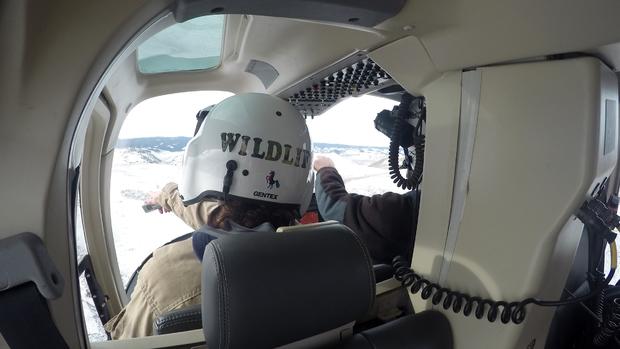Wildlife Officials: Elk Herd Flourishing Despite Habitat Destroyed By Cameron Peak Fire
LARIMER COUNTY, Colo. (CBS4) - Wildlife managers are scrutinizing the movements of thousands of elk that not only survived last year's massive Cameron Peak Fire but apparently continue to thrive. Colorado Parks and Wildlife staffers using GPS collars to track members of the herd say the animals were pushed to lower elevations as the fire expanded, but to places they would have migrated to eventually. They just made the trip earlier than normal.
On Jan. 7, CPW Biologist Angelique Curtis scanned the elk from overhead, counting the animals in the first aerial survey of the herd since the fire. The first aerial survey, in fact, since 2006.
Curtis and helicopter pilot Cameron Stallings classified roughly 4,200 elk during the seven hour flight.
"The elk that we saw today actually summered up where the Cameron Peak Fire burned in the Comanche Peak Wilderness, Long Draw area and up in Dead Man," Curtis said shortly after landing. "What we saw today is that the fire didn't inhibit them from actually getting to their wintering ground. We did see healthy animals, so the fire didn't seem to affect them health-wise."
Pilot Stallings swooped in low, quickly and strategically, to pry about three ddozen animals away from the herd at a time.
"A lot of animal welfare goes into it," said Stallings, Chief Pilot from Aero Tech, Inc. "You don't want to run them through fences or over cliffs or run them too long, things like that."
"It is definitely the pilot and his skills that get us the data we need," Curtis added.
The Cameron Peak Fire began Aug. 13th and ran immediately downhill toward Chambers Lake, causing immediate evacuations. It wasn't contained until early December.
RELATED: Hiker Shares Pictures Of Cameron Peak Fire With Investigators | Cameron Peak Fire Contained 112 Days After It Started
It became the largest fire in recorded Colorado history, the only fire to torch more than 200,000 acres.
A large portion of that burn area is the summer habitat of this elk herd called E-4.
The long-term impacts to the herd largely depend on the amount of moisture the burn area receives this winter and spring. Managers like Curtis are curious to see if the herd returns to the same backcountry domain in 2021.
Additional collars and further monitoring will build a database allowing researchers to document movement patterns, habitat use, reproduction success and causes of mortality. From that, a management model will be created - something CPW has lacked for this herd.
"This is the first year of data and I'll probably need another three or four years of data in order to build the model properly, but I'm getting an idea of how many elk are out on the landscape and how the elk are moving through the landscape," Curtis said.
It will also give CPW more concise population numbers to consider when dolling out permits for fall hunting season.
Monetary support for the study comes from the Larimer County Habitat Partnership Program and the Rocky Mountain Elk Foundation.





